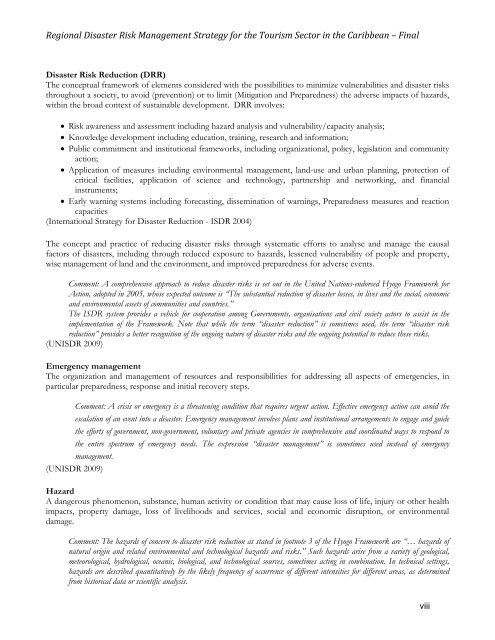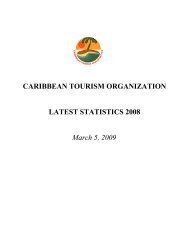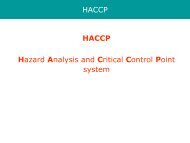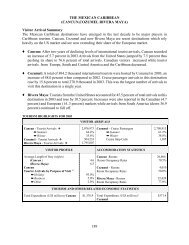Disaster Risk Management Strategy and Plan of Action - Caribbean ...
Disaster Risk Management Strategy and Plan of Action - Caribbean ...
Disaster Risk Management Strategy and Plan of Action - Caribbean ...
You also want an ePaper? Increase the reach of your titles
YUMPU automatically turns print PDFs into web optimized ePapers that Google loves.
Regional <strong>Disaster</strong> <strong>Risk</strong> <strong>Management</strong> <strong>Strategy</strong> for the Tourism Sector in the <strong>Caribbean</strong> – Final<br />
<strong>Disaster</strong> <strong>Risk</strong> Reduction (DRR)<br />
The conceptual framework <strong>of</strong> elements considered with the possibilities to minimize vulnerabilities <strong>and</strong> disaster risks<br />
throughout a society, to avoid (prevention) or to limit (Mitigation <strong>and</strong> Preparedness) the adverse impacts <strong>of</strong> hazards,<br />
within the broad context <strong>of</strong> sustainable development. DRR involves:<br />
• <strong>Risk</strong> awareness <strong>and</strong> assessment including hazard analysis <strong>and</strong> vulnerability/capacity analysis;<br />
• Knowledge development including education, training, research <strong>and</strong> information;<br />
• Public commitment <strong>and</strong> institutional frameworks, including organizational, policy, legislation <strong>and</strong> community<br />
action;<br />
• Application <strong>of</strong> measures including environmental management, l<strong>and</strong>-use <strong>and</strong> urban planning, protection <strong>of</strong><br />
critical facilities, application <strong>of</strong> science <strong>and</strong> technology, partnership <strong>and</strong> networking, <strong>and</strong> financial<br />
instruments;<br />
• Early warning systems including forecasting, dissemination <strong>of</strong> warnings, Preparedness measures <strong>and</strong> reaction<br />
capacities<br />
(International <strong>Strategy</strong> for <strong>Disaster</strong> Reduction - ISDR 2004)<br />
The concept <strong>and</strong> practice <strong>of</strong> reducing disaster risks through systematic efforts to analyse <strong>and</strong> manage the causal<br />
factors <strong>of</strong> disasters, including through reduced exposure to hazards, lessened vulnerability <strong>of</strong> people <strong>and</strong> property,<br />
wise management <strong>of</strong> l<strong>and</strong> <strong>and</strong> the environment, <strong>and</strong> improved preparedness for adverse events.<br />
Comment: A comprehensive approach to reduce disaster risks is set out in the United Nations-endorsed Hyogo Framework for<br />
<strong>Action</strong>, adopted in 2005, whose expected outcome is “The substantial reduction <strong>of</strong> disaster losses, in lives <strong>and</strong> the social, economic<br />
<strong>and</strong> environmental assets <strong>of</strong> communities <strong>and</strong> countries.”<br />
The ISDR system provides a vehicle for cooperation among Governments, organisations <strong>and</strong> civil society actors to assist in the<br />
implementation <strong>of</strong> the Framework. Note that while the term “disaster reduction” is sometimes used, the term “disaster risk<br />
reduction” provides a better recognition <strong>of</strong> the ongoing nature <strong>of</strong> disaster risks <strong>and</strong> the ongoing potential to reduce these risks.<br />
(UNISDR 2009)<br />
Emergency management<br />
The organization <strong>and</strong> management <strong>of</strong> resources <strong>and</strong> responsibilities for addressing all aspects <strong>of</strong> emergencies, in<br />
particular preparedness, response <strong>and</strong> initial recovery steps.<br />
Comment: A crisis or emergency is a threatening condition that requires urgent action. Effective emergency action can avoid the<br />
escalation <strong>of</strong> an event into a disaster. Emergency management involves plans <strong>and</strong> institutional arrangements to engage <strong>and</strong> guide<br />
the efforts <strong>of</strong> government, non-government, voluntary <strong>and</strong> private agencies in comprehensive <strong>and</strong> coordinated ways to respond to<br />
the entire spectrum <strong>of</strong> emergency needs. The expression “disaster management” is sometimes used instead <strong>of</strong> emergency<br />
management.<br />
(UNISDR 2009)<br />
Hazard<br />
A dangerous phenomenon, substance, human activity or condition that may cause loss <strong>of</strong> life, injury or other health<br />
impacts, property damage, loss <strong>of</strong> livelihoods <strong>and</strong> services, social <strong>and</strong> economic disruption, or environmental<br />
damage.<br />
Comment: The hazards <strong>of</strong> concern to disaster risk reduction as stated in footnote 3 <strong>of</strong> the Hyogo Framework are “… hazards <strong>of</strong><br />
natural origin <strong>and</strong> related environmental <strong>and</strong> technological hazards <strong>and</strong> risks.” Such hazards arise from a variety <strong>of</strong> geological,<br />
meteorological, hydrological, oceanic, biological, <strong>and</strong> technological sources, sometimes acting in combination. In technical settings,<br />
hazards are described quantitatively by the likely frequency <strong>of</strong> occurrence <strong>of</strong> different intensities for different areas, as determined<br />
from historical data or scientific analysis.<br />
viii

















